“Sitting is the new smoking,” tweeted Stuart Millinship on August 27, 2010. This tweet was a response to a post “reporting that even if you get plenty of physical exercise, sitting down all day reduces your lifespan.”
At first glance, Millinship’s tweet may sound like hyperbole, but it is based on the views of academics like Dr. James Levine, the man who invented the treadmill desk.
Dr. Levine, who is also the director of the Mayo Clinic – Arizona State University Obesity Solutions Initiative, argues that “Sitting is more dangerous than smoking, kills more people than HIV, and is more treacherous than parachuting.” Concluding, “We are sitting ourselves to death.”
The views above lead us to a vital question: Is sitting as harmful as smoking?
In this article, we attempt to answer the question above. To do this, we spent some time looking at what the latest research says about sitting. If sitting is indeed so bad that it can be compared to smoking, we find ourselves with a second question: Are standing desks the answer?
Are We Sitting Way Too Much?
An article published by Time Magazine is headlined “Most Americans Spend Way Too Much Time Sitting Down.” But how bad is the situation? Here are some numbers.
- 25% of American adults sit for more than eight hours a day.
- Only 3% of adults say that they sit for less than four hours a day.
- An average person spends 12 hours sitting every day.
- In the 1960s, jobs involving physical activity made up 50% of the workforce in the US; today, they constitute only 20%.
- Office workers sit for 15 hours a day.
- In the EU, only 20% of employed people spend most of their working time standing up.
Regarding the question as to whether we are spending too much time sitting, the numbers above provide the answer: an emphatic yes. This implies we have a reason to be concerned, especially if we accept that sedentary lifestyles are associated with a host of health problems and an increased risk of death.
Prolonged Sitting Has Negative Effects
The idea that prolonged sitting has adverse effects is well established. For instance, the UK’s National Health Service (NHS) says that “Sitting for long periods is thought to slow the metabolism, which affects the body’s ability to regulate blood sugar, blood pressure and break down body fat.”
A study published by the American Journal of Epidemiology supports the view that prolonged sitting has detrimental effects. The study starts by noting that the obesity pandemic is partly due to reduced physical activity. It reports, “Evidence supports that reducing time spent sitting, regardless of activity, may improve the metabolic consequences of obesity.”
Using this conclusion, the study suggests that public health messages should not only emphasize physical activity but also encourage individuals to reduce the time they spend sitting.
Neville Owen and a group of other scholars agree that the negative effects of sitting can be reduced by encouraging people to couple physical activity with reduced sitting times.
These authors add that the reduction in sitting time can be accomplished by encouraging “widespread use of innovative technologies that can provide more opportunities to reduce sitting time (for example, height-adjustable desks).”
We look at whether standing desks are the right answer to overlong sitting later in this article.
The Health Effects of Prolonged Sitting
It’s clear from the views above that sustained sitting has negative effects. Several scholars have distinguished the health effects of sitting for too long.
The results from their studies associate extended periods of sitting with conditions like cancer, obesity, and diabetes.

Link to cancer
In June 2020, Susan Gilchrist and other academics published the results of a study into the link between sedentary behavior and cancer mortality.
The study involved a little more than 8,000 adults. From the collected data, the researchers concluded that “a greater amount of sedentary time was associated with a higher risk of cancer mortality.”
Based on the conclusions from their study, Gilchrist and her core researchers have a suggestion: lower the amount of time you spend sitting. This is because “Replacing sedentary time with light- or moderate- to vigorous-intensity physical activity was associated with reduced cancer mortality risk.”
In a critical analysis of the conclusions drawn by Gilchrist and her colleagues, Gretchen Reynolds notes some limitations. For instance, Reynolds observes that the study focuses on cancer mortality and not the risk of developing the disease.
She also notes that the study “offers no clues about how sitting raises that risk, and whether inactivity directly changes our bodies or if other factors, including what we eat or drink while seated, influence how sitting raises our risk of dying from cancer.”
Raised Risk of a Host of Conditions
Researchers have also been hard at work attempting to find out why prolonged sitting has harmful health consequences. An article published by Harvard Health Publishing proposes that one potential reason is that your largest muscles relax when you sit, reducing glucose uptake from the blood. This escalates the risk of conditions like type 2 diabetes.
The Harvard Health Publishing article supports the suggestion that it’s important to take constant breaks after long blocks of sitting or get an adjustable standing desk.
The Mayo Clinic identifies other conditions whose risk is escalated by habitual inactivity. These include “obesity and a cluster of conditions — increased blood pressure, high blood sugar, excess body fat around the waist and abnormal cholesterol levels — that make up metabolic syndrome.”
Effects of Prolonged Sitting on Mental Health
Not only does prolonged sitting affect the body, but it also impacts the brain. This view is supported by a study published by the Journal of Psychiatry Research, which concludes that “Those reporting over 10 h sitting/day were more likely to present depressive symptoms.”
Dominika Pindus and colleagues conducted a study exploring the relationship between prolonged sedentary time, physical activity, and cognitive control. When they published the results of their study in February 2021 in the International Journal of Obesity, they concluded that there was “a specific relationship between prolonged ST [sedentary time] and poorer inhibitory control.”
Inhibitory control, also called response inhibition, denotes the ability of an individual to control the urge to act in a particular way when triggered by an impulse. Self-control is a crucial part of inhibitory control.
Will Prolonged Exercise Reverse the Effects of Prolonged Sitting?

It’s clear from the research conclusions above that we are sitting way too much. The fact that sedentary lifestyles are not suitable for our health is now well established.
What is new in the research we came across when preparing to write this article is that sitting for prolonged periods is bad for your health even if you exercise a lot.
For instance, a paper published by the National Library of Medicine concludes that “Reducing inactivity by increasing the time spent walking/standing is more effective than one hour of physical exercise when energy expenditure is kept constant.”
It’s important, however, to note that conclusions indicating that doing a lot of physical exercises will not necessarily cancel the effects of prolonged sitting do not suggest that physical exercise is not essential when you don’t sit a lot. Instead, they propose that both reduced sitting time and physical exercise should be seen as requirements for an active lifestyle.
Is Sitting the Same as Smoking?
The idea that sitting for too long is as dangerous as smoking has been supported by many publications. But is this an accurate analogy? It looks like the research conclusions drawn by various medical experts suggest that comparing sitting with smoking is unjustified.
An article published by ScienceDaily.com cites Dr. Terry Boyle, an epidemiologist at the University of South Australia, who says, “The simple fact is, smoking is one of the greatest public health disasters of the past century. Sitting is not, and you can’t really compare the two.”
Dr. Boyle also argues that “unlike smoking, sitting is neither an addiction nor a danger to others.” He suggests that anyone attempting to equate sitting to smoking risks trivializing the dangers connected with smoking.
In an article published by the US National Library of Medicine’s National Institutes of Health, Jeff Vallance and his colleagues support Dr. Boyle’s views. They note: “Given the current state of the evidence, equating sitting with smoking is unwarranted, misleading for the public, and may serve to distort and trivialize the ongoing and serious risks of smoking.”
On the side of the debate sit those who say that prolonged sitting presents the same danger as smoking, if not worse. An analysis of available reports shows that media outlets, even credible ones, mainly drive the idea that sitting is the new smoking.
Even though suggestions that sitting is the new smoking can be dismissed as hyperbole, it can be concluded that sitting for prolonged periods, even in a well-designed ergonomic office chair, is linked to some negative outcomes. This is because sitting is closely associated with sedentary lifestyles, which have been shown to result in a host of health problems.
Are Standing Desks the Solution?

If we agree that sitting heightens the risk of health conditions, could standing desks be the solution? Research has weighed in on this too. Healthline.com reports that “The idea that standing is better for heart health was first proposed in 1953.”
A study conducted by John Buckley, Duane Mellor, Michael Morris, and Franklin Joseph, published by the National Library of Medicine, concluded that there was a rapid reduction in blood sugar among people who worked standing compared to sitting.
The researchers suggest that the benefits of doing work while standing are more pronounced after eating. The positive effects of standing desks are related to the fact that people burn more calories when standing than they do when sitting.
The National Library of Medicine also published a study that concluded: “using a sit-stand device at work can reduce sitting time and generate other health benefits for workers.” The same study says that devices that encourage more standing, like standing desks, can help reduce back pain.
While many studies encourage the use of standing desks, it’s important to note that standing should be done in moderation because it is likely that standing for prolonged periods may result in discomfort.
Is It Still Bad to Sit a Lot?
From available studies, it’s clear that prolonged sitting and the sedentary lifestyle associated with it are bad for our health. However, this doesn’t mean that sitting on its own is bad.
Like everything else, when overdone, sitting will hurt your health. The same applies to standing; if you overdo it, you will likely end up with problems.
To answer our initial question, we can say that prolonged sitting is still bad for you. However, a healthy lifestyle is a multipronged approach that does not solely depend on one aspect like sitting versus standing.
This means that we need a healthy dose of sitting, standing, healthy food, rest, and exercise. So, don’t throw away that chair yet, but certainly, consider getting yourself a standing or treadmill desk.
If getting a standing desk is not possible, take more breaks between long periods of sitting.